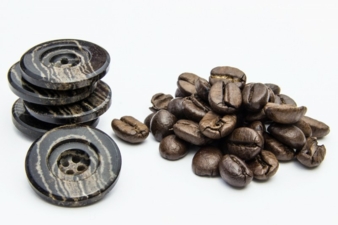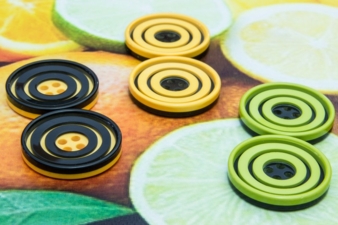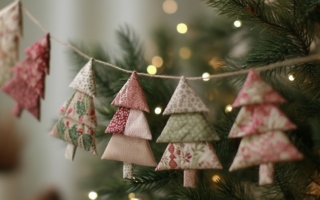28/01/2015 — auf Deutsch lesen
Sheer joy of living
In the spring/summer 2015/2016 season, design trends are following modern consumers and all their sensitivities. From highly chic to highly natural, from overflowing joie de vivre to abstract or casual asceticism – a bag of wondrous surprises is opening up.
In spite of the good September figures, the start of the spring/summer 2016 ordering period showed “few signs of a cyclical turn at the end of the year”, according to the German Textile+Fashion Confederation in its economic report of November 2014. Regardless of this, many a trimmings manufacturer is reflecting, as the German company Kahage GmbH is, on “a very successful year”. The same is also true for the Butonia Group as a whole, of which Kahage is a part.
Especially for the second half of the year, director Christian Kurzrock has recorded a highly positive business performance, on the back of the successes of the previous year. He attributes this to good value for money, the result of consistent cost management, a high level of service and a modern, high-quality collection that new customers are also finding persuasive. German manufacturer Madeira Garnfabrik is similarly reporting consistent or gently rising sales figures in its international markets, with very few exceptions.
From a fashion point of view, for spring/summer 2016 the international designers (including Kenzo), sometimes quite disconcertingly, have hidden all evidence of body shape beneath extremely wide and long garment shapes. For Jo Baumgartner, fashion expert at the German textile fair Munich Fabric Start, the key motif for the new season is not beauty but provocation. Shapes and colours from the 70s, 80s and 90s are blended together. The tried and trusted combination of elegance and sportiness, however, continues to carry weight, while transparency and layering are intrinsic elements of the whole system.
‘Oscillating Identities’ is the overall theme of Munich Fabric Start. It addresses the way in which people shuttle between different identities without ever losing track of themselves. ‘Neo-modernism’, on the other hand, is the title of the Italian textiles trade fair Milano Unica, comprising two elements – ‘Designed Simplicity’ and ‘Artistic Boldness’.
It was already apparent at the Denim by Première Vision event in Barcelona that white and ecru were becoming extremely important. Beside these, ‘plastic colours’ such as royal blue, pink and vivid shades of green and orange, tamed by black and white, promise much joie de vivre, whilst the avant-garde retreats into sombre winter colours. Bright metallic accents in modern gold, copper and bronze tones are still important and are accompanied by white fastenings (Stenger by Germany’s Bodo Jagdberg).
Many of the fabric and trimmings themes radiate contemplation and simplicity (‘Self Essence’, Munich Fabric Start). This is a minimalist, single-minded chic – sometimes sporty, sometimes natural – and not infrequently, trimmings and fabrics coalesce in gently toned harmonies. Porcelain-like, calcareous or clear-varnished surfaces bring the materials up to date, as do ribbons and labels. Organdie, fine fils coupés, canvas with a transparent PVC coating and white or heavily bleached denims come face-to-face with graphic positive-negative jacquards and print designs.
Delicate pen-and-ink drawings, crossed lines, lasered holes and graphically arranged metal appliqués like pinheads, not to mention transparent layers, provide a suitable setting for the labels, as they do for the ribbons and buttons. On metallic trimmings, transparent coatings provide fascinating new optical effects, while chromatic and pale pastel-shading prints and coatings lend a visual charm even to transparent fabrics. Elegant horn, ivory palm or mother-of-pearl buttons blend in harmoniously or offer a gentle contrast. Clean patent buttons with nickel, white gold and copper rivets (Bodo Jagdberg, ‘Tech Nouveau’) provide fashionably modern highlights. Matte-lacquered press-studs, carabiner hooks and zip tags with colour gradients reference the sport couture, together with latex, foil and mesh-looks, matte transparencies and rubberised effects.
Knopf & Knopf International have enhanced natural wooden buttons with shiny metal detail but have also used wooden elements on zip tags, ball knobs and ribbon-ends. ‘Respectus’ is the name that Bornemann Etiketten of Germany have given to their down-to-earth, sustainable theme, which plays with earthy colours, natural materials and shapes and geometric patterns. At Kahage-Butonia, the nature theme culminates in buttons made of ground recycled coffee that can be lasered to order.
Contrasting materials such as the combination of cord and a futuristic design, from Knopf & Knopf International, create excitement. Coarsely textured labels in ramie or linen follow the Italian ‘Al naturale’ (Milano Unica). These work well with summer bouclés and Chinés in silk and linen. A casual yet classic effect comes from the many used-look items, ranging from washed fabrics and labels to tumbled buttons.
In addition, a wide range of different cultures are brought together in a life-affirming mixture of patterns and materials, accompanied by jungle and artistic tricks. Energetic colours combine with folkloristic fruit and jungle shades, and with naïve prints – always with a shot of irony. And fashion thus dreams its way through different eras, different worlds. Munich Fabric Start revealingly calls this ‘dream patching’. Within this theme there is a repeated recurrence of retro classics such as faded blue, a retro green, a sporty purple-tinged red, and sand. Once again a breath of Mediterranean summer wafts through the fashion, though spiced up with more ‘technical’ elements.
These include an abundance of stripes and nautical motifs. By contrast, cheeky-cheerful abstract comic motifs on zip tags and other trimmings communicate a carefree attitude to life. Knopf & Knopf International (‘Pop you up!’) is also using a variety of plastics, rubberised buttons in mother-of-pearl colours, or outsized accessories such as giant clasps, buttons, bows and plastic chains as fasteners. Large-scale letters cover the labels. Postcard prints bring into view well-known locations and monuments. Chaotically arranged gaudy plastic stones are unleashed on trinkets, brooches and ribbons. Bodo Jagdberg (‘Make a Smile’) does indeed bring a smile to the face with rivets in the shape of kissing lips, cherries and bananas, with brash and iridescent spherical rivets and with glitter-effect buttons.
Last but not least, constructivist designs and intensive colours keep jacquards and prints in the game. German company Topp Textil, specialist ribbon producers, is bringing jacquard ribbons with unusual patterns to the fore for next season. Intensive colours sit alongside white, black and grey. There is a mixture of different surface structures, and holes and cut-outs remain a major theme. The exotic still has its grip firmly on fashion! Blurred or distorted jungle motifs have undergone psychedelic alienation. Giant flower motifs are patched with other designs.
Used looks are allowed to reveal gauze while incrustations speak of handcraft and wealth. The demand for embroidered goods is on the rise, notably in tufting techniques as confirmed by Madeira and the German embroiderers Stickerei Müller. Lasered palm trees and Hawaiian designs are evident on looped labels (Stenger by Bodo Jagdberg). Hibiscus flowers decorate press-studs, pins and iron-on motifs (Bodo Jagdberg). Masai pearls, bones, ivory palm, wood and coconut decorate the sumptuous pool of materials (Knopf & Knopf International). Used-effect brass and bronze, alongside elaborate structures, bring a noble tone to the theme.
[Regine Hövelman]





